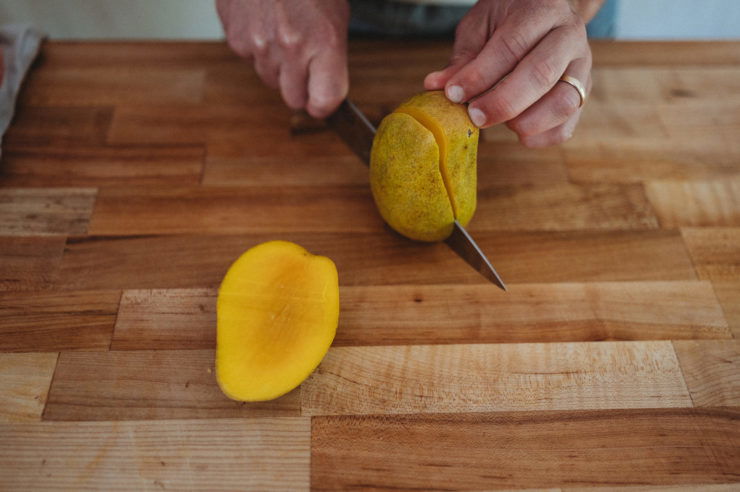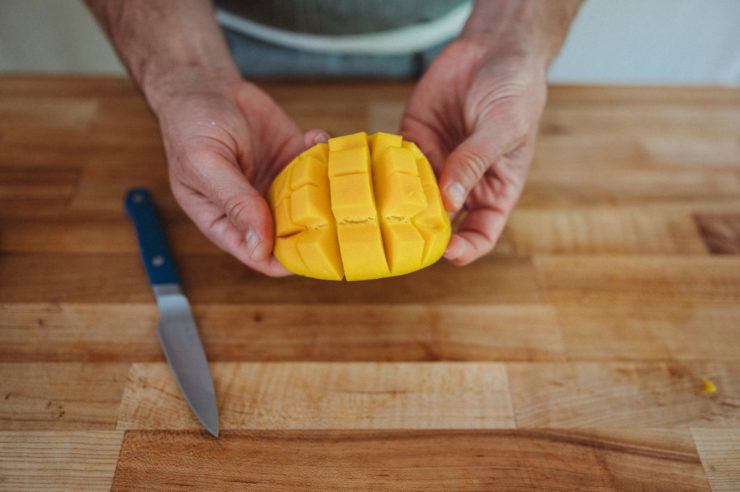Mangoes are delightful to eat in their raw (but ripe) state.
The problem is that they can be difficult to prepare because of their large oblong pit, and slippery flesh. The peel is also bitter to taste if you don’t remove it entirely.
While working in high-end restaurants as a pastry chef, I learned that mango can be used in dessert recipes for everything from ice cream to candies and buttercreams too.
When you’re doing high-volume work like that, it’s especially important to find fast and safe ways to get the job done. Mango prep is no exception!
While you probably aren’t pumping out mass mango treats from your kitchen, most people can still benefit from the tips and tricks I learned along the way.
In this article, I’ll cover the easiest and safest way to cut mangoes for common preparations, plus how to pick a perfectly ripe fruit every time.
In This Article
Equipment You’ll Need
A Sharp Kitchen Knife
To start, you’ll need a sharp kitchen knife with a handle that’s easy to grip. Mango flesh can be tough, so a sharp blade is essential for safety while cutting. A chef knife tends to work best.
Cutting Board
Always use a clean cutting board with no garlic or onion scent residue, as mango will soak up these flavors easily.
Paring Knife (optional)
Having a paring knife on hand can be helpful if you’re not comfortable navigating smaller pieces of slippery fruit with a full-size knife.
How to Cut a Mango Easily
1. Hold upright
Hold your mango upright on the cutting board with the stem facing up.
2. Find the wide side
Prepare to cut by finding the wider, flatter side of the fruit. (As the stem is wide, flat, and oblong, the fruit follows this shape and has distinct sides.)
3. Slice off one side

Using your knife, start your cut about 1cm from the stem, slicing off one wide side of the fruit.
4. Repeat

Repeat this process on the other side of the fruit, cutting off the other “cheek.”
5. Cut remaining narrow sides

Use your knife (this is where a paring knife can be helpful) to carefully shave off the remaining pieces from the narrow sides of the fruit. Follow the shape of the pit with your blade as you cut. These pieces may not be very uniform in appearance, but they’re still perfect to eat.
6. Dice by placing skin side down

To dice, place one of the large “cheeks” that you’ve cut onto your cutting board, skin side down. This method allows you to use the leathery skin to your advantage and prevent slipping while cutting.
7. Cut vertical lines

Use your kitchen knife to gently cut vertical lines at the width you’d like your mango pieces to be. Cut through the fruit, but not through the skin.
8. Turn 90 degrees and cut again

Turn the fruit 90 degrees and cut vertical lines in the other direction, making a grid pattern, still cutting through the fruit but not the skin.
9. Separate peel from fruit with knife

To separate the diced cubes from the skin, hold your knife with the flat body of the blade parallel to the cutting board. Then begin your cut just above the skin of the fruit, slicing horizontally under the cubes. Repeat with the remaining half of the mango.
10. Remove peel from narrow pieces
For the smaller pieces from the narrow sides of your mango, it may be easier to remove the skin first with the same method in step 9. Then cut to your desired shape if needed.
To cut your mango into slices, complete the same process, skipping step 8.
Storing Cut Mango

To store cut mango, keep it in the fridge in an airtight container. It will usually stay fresh for two to five days, depending on ripeness. Cut mango can also be frozen and used for smoothies and other purées.
While mangoes may seem like more of an “advanced” fruit in terms of preparation, they’re relatively simple to cut once you understand the basic techniques to get around their large pit.
When it comes to safety, their slippery flesh is best navigated by dicing with the skin side down, then removing the peel after.
If you’d like to get creative with your own ideas for a recipe with mango in it, this Guide to Flavor Principles can help you on your way (hint: mango has a sweet flavor with a touch of sour).
How to Pick the Best Mango

The next time you’re mango shopping, look for fruit that appears roundish and plump.
Your fruit should be just soft enough to yield if you press on them. Smell the fruit where the stem is – if it smells sweet and fragrant, you have found a ripe mango!
You’ll want to avoid any fruits that have dark, smooshy spots or flat sides. Flatter mangoes may indicate a stringy texture inside, which can be unpleasant to eat.

Pro tip: Ataulfo mangoes (sometimes called Champagne mangoes) are smaller and yellow, and can be softer and even a little wrinkly before they’re fully ripe.
If you can only find unripe mangoes, let them sit out at room temperature for a couple of days or longer until they’re slightly soft and fragrant as described above. They can also be placed inside a paper bag to ripen, just try not to forget about them!
Frequently Asked Questions
Should you peel a mango before cutting?
No. Because mango flesh is so slippery, it’s best to cut the sides of the mango off first, then remove the peel.
What is the easiest way to prepare a mango?
Hold the mango stem up and cut off the wider sides of the mango, following the contour of the flat pit inside. Then hold cut pieces skin side down on a cutting board to slice off the skin.
Can you peel a mango with a potato peeler?
Yes, the skin can be removed with a vegetable peeler. However, it’s not a recommended method due to the slippery nature of mango flesh.

How to Cut a Mango
- Total Time: 5 minutes
- Yield: Varies
Description
Learn how to cut a mango safely and easily with step-by-step instructions. This sweet and slightly sour fruit can enhance salads, desserts, and even meat dishes.
Ingredients
- 1 Mango
Instructions
- Hold mango upright with the stem facing up.
- Find one wide, flat side of the fruit.
- Starting a little out from the stem, cut off one “cheek”, following the shape of the pit.

- Repeat for the other side of the fruit.

- Use a paring knife to remove the remaining fruit from the pit, cutting along its shape.

- Prepare to dice by placing the cut mango skin side down on the cutting board.

- Cut vertical lines through fruit without cutting through the skin.

- Turn the fruit 90 degrees and repeat step 7.

- Hold your knife’s blade flat against the cutting board, then slice the peel off horizontally.

- Repeat steps 6-9 with the other half of the mango.

- Remove skin from remaining narrow mango pieces as in step 9.
Notes
To cut the mango into slices, use the same process, skipping step 8.
- Prep Time: 5 minutes
- Category: Knife Skills
- Cuisine: Any
Keywords: how to cut mango, how to slice mango, how to dice mango, how to safely peel mango















